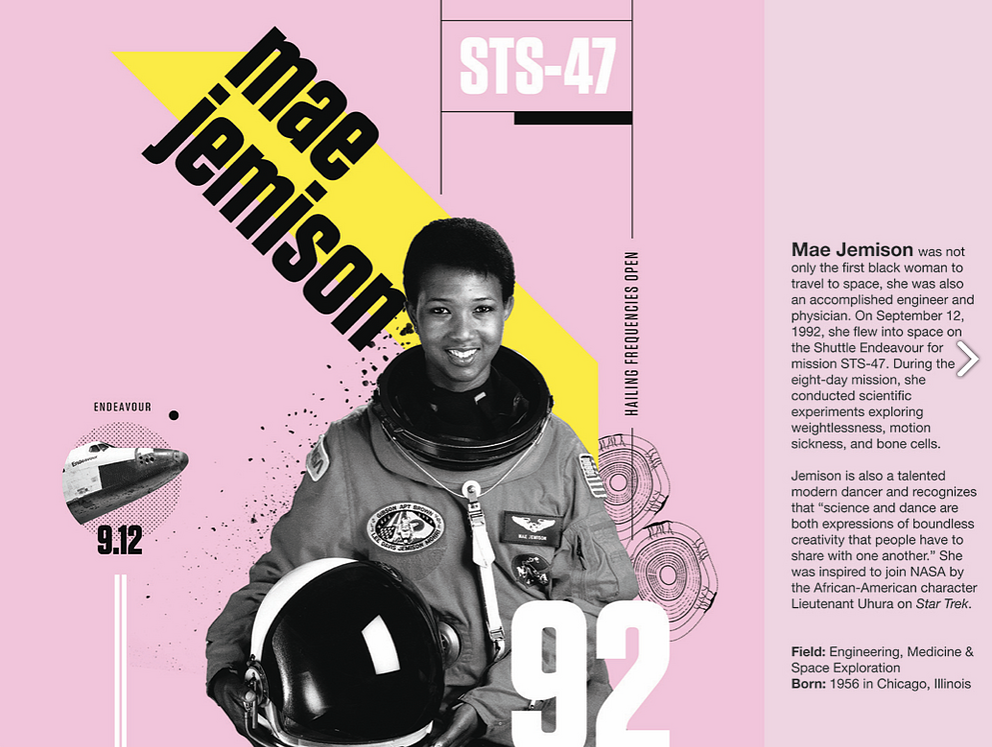Raleigh/ Durham/ Chapel Hill
How Women Made STEM Flourish
by | Jan 16, 2024 11:11 am
Post a Comment | E-mail the Author
Posted to: Visual Art , Museum

Beyond Curie: A Celebration of Women in Science
North Carolina Museum of Natural Sciences
11 W. Jones St.
Raleigh, N.C.
Beyond Curie: A Celebration of Women in Science is a dynamic display of breakthroughs and advances made by a diverse group of women over the last 100+ years.
As visitors step off the elevator on the fourth floor of the North Carolina Museum of Natural Sciences in downtown Raleigh, they’re greeted by walls doused in history making discoveries.
The exhibit, created by Amanda Phingbodhipakkiya, aims to highlight 40 female scientists, mathematicians, and engineers who made contributions as equally as important as Marie Curie, the celebrated Polish and French scientist who studied radioactivity. Curie was the first woman to win a Nobel Prize and the first woman to win it twice.
Beyond Curie explores breakthroughs in a variety of disciplines, including medicine, space exploration, the creation of the atomic bomb, the study of DNA sequences, and engineering. From the words we say to the clothes we wear, to the evolution of computers, TV and medical devices, the exhibit is a fascinating and insightful reminder of how the world has evolved thanks in part to their work.
Each display is filled with vibrant pastel colors, a portrait of the scientist, their work history or unique fact about their journey, and contribution to society. The descriptions are easy-to-digest and provide just enough information for guests to gain a clear understanding of the impact each scientist had on their respective field, and the world at large. This provides a great introduction into who these women were and the advances they made.
The first illustration visitors see on the right-hand side is of Grace Hopper, a trailblazer in computer programming. She’s known for creating the first compiler for computer languages, which translates word-based instructions into a code that can be read by computers. Hopper also coined the terms “computer bug” and “debugging” after finding a moth trapped inside a machine. Learning about the origin of two words that are still widely used today, provides visitors with a welcomed “aha” moment.
Other displays focused on advances in the medical field. Gertrude B. Elion, an American biochemist and pharmacologist, created the first treatments for leukemia, malaria, gout, cancer, and meningitis. Her expansive influence likely saved countless lives across the globe and paved the way for future innovative treatment methods. Elion also developed the first immunosuppressive drug, azathioprine, which is used for organ transplants. She won the Nobel Prize for her work in 1988.
The exhibit also calls attention to a series of women who broke barriers, which can be a source of inspiration for generations to follow. Mary Golda Ross, the first Native American female engineer, was one of the founding members of the Advance Development program at Lockheed Martin. Ross pioneered research on interplanetary space travel, manned and unmanned earth-orbiting flights, and the early study of satellites. Sameera Moussa, an Egyptian nuclear scientist, was the first woman to receive a PhD in Atomic Radiation. Her work led to the creation of a formula that splits atoms in base metals, like copper, which made X‑rays cheaper. Mildred Dresselhaus, a Polish and Jewish scientist known as the “Queen of Carbon Science,” did work groundwork on the technology that allows electronics to be everywhere including clothing and smartphones. And Chein-Shiung Wu, the first Chinese American to be elected to the U.S. National Academy of Sciences, designed the process for creating uranium isotopes for the atomic bomb.
Additionally, achievements made by Black women at NASA are vast and well-emphasized throughout the exhibit. They’re impressive in nature as they involve all facets of research at different points in time. There are displays for the groundbreaking accomplishments of Katherine Johnson, who worked as a human computer to ensure the success of several space flights. Valerie Thomas, who invented the illusion transmitter and other technology that supported comet research, and Mae Jeminson, the first Black woman who traveled to space, are also featured.
The story of Florence Bascom is a captivating reminder of the hurdles women had to overcome in STEM. Bascom was the first woman to receive a doctorate from John’s Hopkins University in 1893. She was forced to sit behind a screen during classes so she wouldn’t distract her male classmates. This sparked audible sighs of frustration and scoffs from some at the exhibit. Bascom went on to become the first woman hired by the US Geological Survey, where she created a comprehensive guide to the geology of the Mid-Atlantic region.
The more visitors learn and engage with the material, the more questions it brings: Why didn’t I learn this in school? Why haven’t their accomplishments been better highlighted? How were they able to come up with this? The exhibit opens the door for visitors to continue exploring and enhancing their knowledge.
Visitors can also interact with an iPad display that features the female scientists who currently work at the museum, and 3D models that are covered in additional discoveries and famous quotes. The “Beyond Curie” exhibit is free and a date for its removal has not yet been announced.